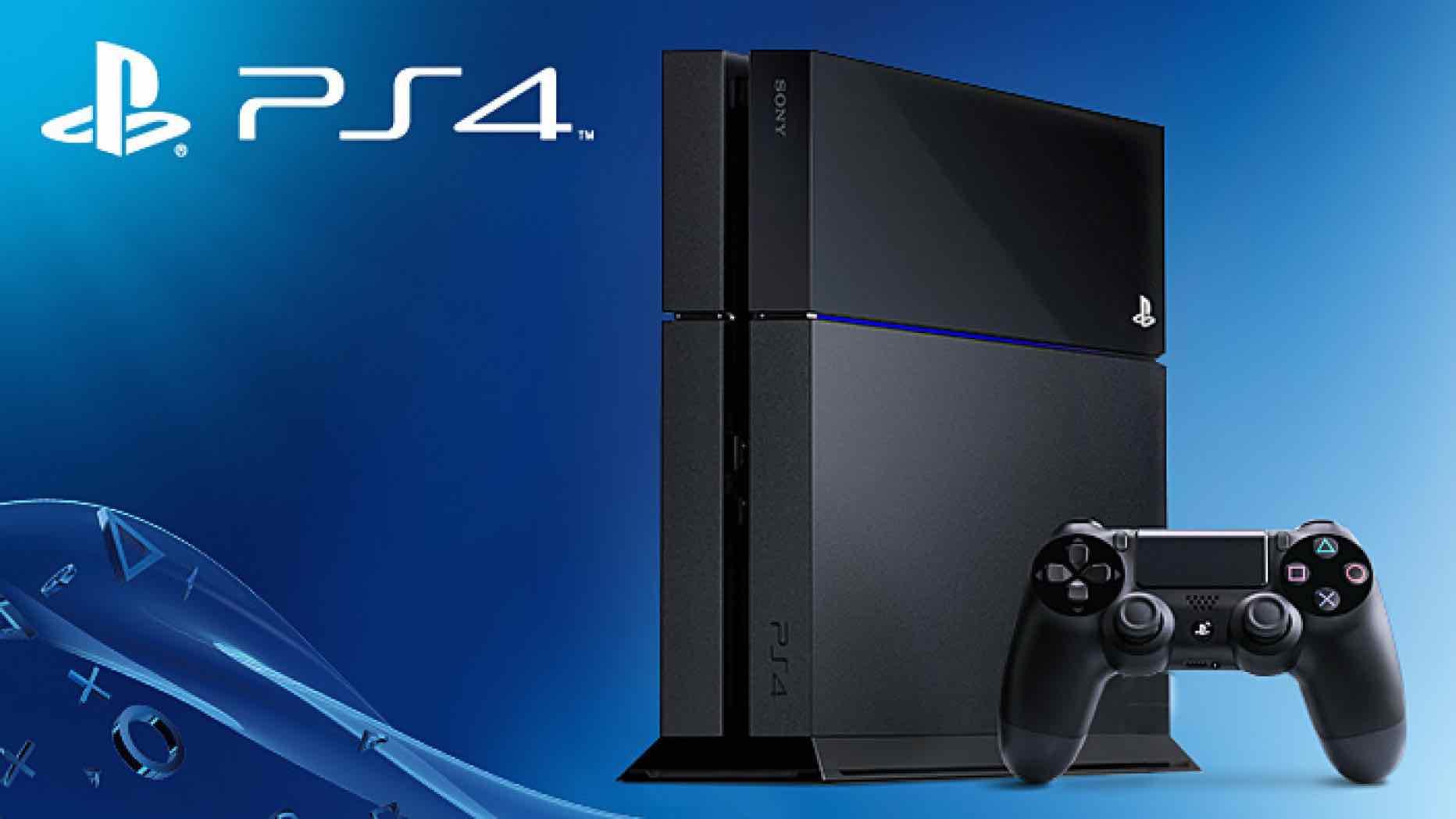For quite some time, gaming monitors have been dominating the scene, replacing the traditional method of gaming on TVs, especially when it comes to console gaming.
Gaming monitors occupying less space, displaying lucid visuals, offering better motion movement, and lower input lags, are among the many reasons as to why gaming on TVs is being replaced slowly but surely.
Now that they took the market by storm, the options have become diverse, and the choice isn’t getting any easier when it comes to picking the best gaming monitor to maximize your gaming experience.
There are several factors to consider, and ticking all the right elements in one gaming monitor is a task easier said than done. We’ve sorted out some of the best monitors for PS4 Pro and reviewed them in-depth.
Hopefully, any pick among them would be the best monitor for you, based on your needs and interests.
Our Top Picks
- Our Top Picks
- The 8 Best Monitors for PS4 Pro in 2020
- 1. Asus VP28UQG – Best 4K Monitor for PS4 Pro
- 2. Asus VG289Q – Best Console Gaming Monitor
- 3. LG 27UL500-W – Budget Monitor for PS4 Pro
- 4. Philips Momentum 436M6VBPAB – Hybrid Computer Monitor
- 5. LG 27UL650-W – 4K HDR Gaming Monitor With FreeSync
- 6. BenQ EX2780Q – Optimal All-Rounded Gaming Experience
- 7. Samsung U32J590 – Affordable 32″ Gaming Monitor
- 8. Samsung C27HG70 – Top Curved Gaming Monitor
- What To Look For When Buying a Monitor for PS4 Pro
- Frequently Asked Questions:
- Is It Worth Getting a 144 Hz Monitor for PS4 Pro?
- Is It Worth Getting a 4K Monitor for PS4 Pro?
- What Is the Best 4K Monitor for PS4 Pro?
- Is It Better to Play PS4 Pro on Monitor or TV?
- Final Thoughts
The 8 Best Monitors for PS4 Pro in 2020
1. Asus VP28UQG – Best 4K Monitor for PS4 Pro

If you consider yourself a real gamer that continues playing games for hours on repeat, then you should consider the ASUS VP28UQG, mainly due to the embedded ASUS Eye Care Technology that protects your eyes from the extra eye strain through lowering blue light and eliminating flickering.
That’s not what the ASUS VP28UQG is all about, though, so continue reading. The 28-inch 4K monitor uses a TN panel, which supports higher refresh rates and low response rates along with high resolutions. The response rate of this monitor is 1s, so remove ghosting and blurring from your dictionary, while the refresh rate is 60 Hz and the peak brightness is 300 nits.
In addition, it supports viewing angles with minimal image quality distortion, allowing you to view the monitor vividly from any desired angle.
Port-wise, the ASUS VP28UQG includes two HDMI 2.0 ports, one DisplayPort 1.2, and a headphone jack.
AMD FreeSync technology is one of the features of the monitor, and so is GamePlus. These two features combined give you the best gaming experience, with the former giving you a smooth display and the latter enabling you to adjust the monitor’s settings while you’re playing games depending on the ambiance. Lastly, Flicker-Free technology minimizes flicker to make the experience comfortable.
Pros:
- Eye-care technology
- Affordable price
- AMD FreeSync, GamePlus, and Flicker-Free technologies
- 1s response rate
- Multiple view angles
- Vivid display
Cons:
- Lacks HDR support
- Can only be tilted
- Lacks internal speakers
Bottom Line
The ASUS VP28UQG is a prime gaming monitor, given its super-low response rate of 1s, and just-right display size with a 28-inch screen. It’s most suited for the competitive gamers who will enjoy the best gaming technologies to make their experience as smooth as could be!
2. Asus VG289Q – Best Console Gaming Monitor
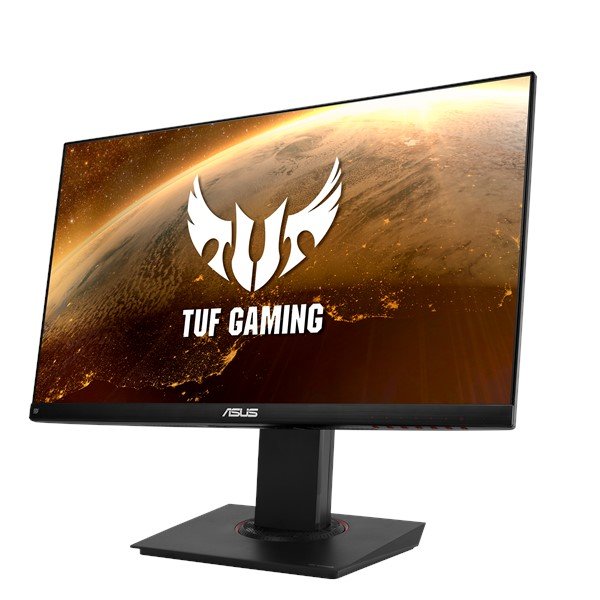
Providing a hybrid between reasonable price and the ideal console gaming experience, the ASUS VG289Q is one of the top IPS panel monitors with a broad color gamut and diverse features adding to the enjoyability of the gaming journey.
The monitor’s IPS panel has a 10-bit color, assuring you that you’ll see nothing short of vibrant and consistent colors on your screen. It can support the display of 1.07 billion colors. Furthermore, the 28-inch monitor features 4K Ultra HD resolution, resulting in high pixel density which sheds light on the tiniest of details in full clarity, not to mention the screen space itself.
If you plan on using the monitor for purposes other than gaming, such as reading text, for example, you will probably need to scale your graphical user interface to get a more clear and sharp view of the text, despite the fact that this will limit your available screen space. You can also multi-task on the monitor through the Display Alignment feature.
Moving on to the game-enhancing features, the ASUS VG289Q features FreeSync technology, includes pre-calibrated picture resets for FPS, RTS/RPG, MOBA, and racing genres. In addition, it includes a “Shadow Boost” feature to increase visibility in games with dark sceneries. What’s more, the “GameFast Input Technology” works on gameplay fluidity, through reducing input lag.
Combining these features with the monitor’s 5ms response time, you can already see why this gaming experience is one like no other; both responsive and immersive. As for the refresh rate, the ASUS VG289Q provides a variable refresh rate (VRR) with a range of 40-60 Hz/FPS, which completely eliminates screen tearing.
Finally, the monitor’s connectivity includes two HDMI 2.0 ports, one DisplayPort 1.2, a headphones jack, and dual 2W speakers. In addition, it has a set of connectors to allow you to plug in a PC and more, and it comes with a stand for adjustment of height, swivel, tilt, and orientation.
Pros:
- Rapid response time
- Multiple gaming features
- Ergonomic design
- Dazzling color display and wide color gamut
- Variable Refresh Rate
- Reasonable price point
Cons:
- Entry-level HDR support
Bottom Line
The ASUS VG289Q is for the gamers desiring the most interlocking gaming experience through intensifying features, but are not primarily concerned with optimal performance. It combines the main features gamers would look for in monitors without driving up to an extravagant price.
3. LG 27UL500-W – Budget Monitor for PS4 Pro
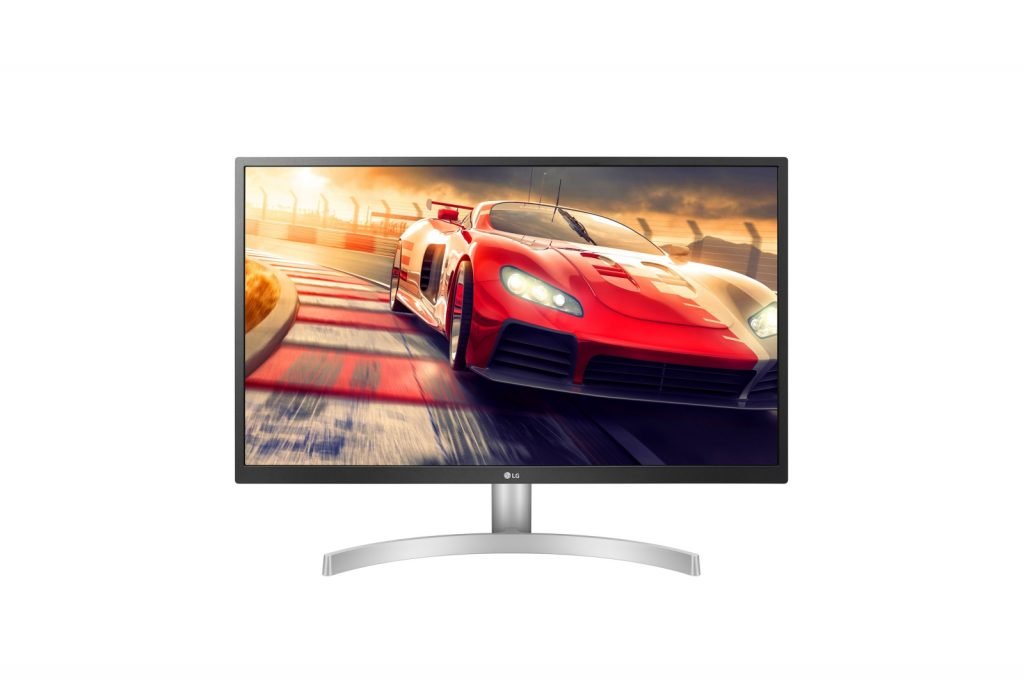
The LG 27UL500 is the optimal choice if you’re seeking a 4K monitor without necessarily breaking the bank. In all fairness, the design is basic and can give a bulky impression, but when things get serious, the display is completely satisfactory, particularly given the price range.
The monitor has a 27-inch 4K display, and that itself is a sufficient guarantee that the visuals will be as clean as a whistle. Not to mention, LG has its own technology, the LG True Color Pro Calibration Technology, making the colors appear accurate as could be.
While that’s satisfactory enough for many, the LG 27UL500 goes the extra mile for the hardcore players who want a picturesque experience while playing games. It, therefore, features an HDR10-compatible IPS monitor panel, to make the graphics extra vivid. It’s worth noting, however, that the peak brightness is only 300 nits, which is justifiable given the price.
The response rate is 5s, while the refresh rate is 60 Hz.
On the connectivity front, the LG 27UL500 lays low, coming accompanied by the basic DisplayPort 1.2, two HDMI ports (2.0), and a headphone jack. Furthermore, as an extra, the monitor also comes with an adjustable stock stand to allow for tilting.
However, if you know you’ll need more than just a stock stand, be assured that the LG 27UL500 has VESA support and is compatible with 100×100 VESA mounts, allowing for more flexible adjusting, pivoting, swiveling, and elevation.
Last but not least, the monitor features AMD FreeSync, an adaptive technology that offers a dynamic refresh rate to allow for circumstances such as being unable to maintain a stable 60 FPS in the 40-60 FPS range yet don’t want to limit the gaming performance at 30 FPS using V-Sync.
Pros:
- Affordable
- AMD FreeSync
- 300 nit peak brightness
- Superb IPS display
- Accurate color display
- HDR support
- Game Mode tweaking settings
Cons:
- Unappealing design
- Relatively bulky
- Basic functioning stock stand
Bottom Line
The LG 27UL500 gaming monitor is your best alternative if you’re hunting for a reasonably priced gaming monitor that offers quality display. With its HDR support through 4K IPS monitor panel, you’re assured a lively gaming experience that will compensate for the minimal shortcomings of the monitor.
4. Philips Momentum 436M6VBPAB – Hybrid Computer Monitor
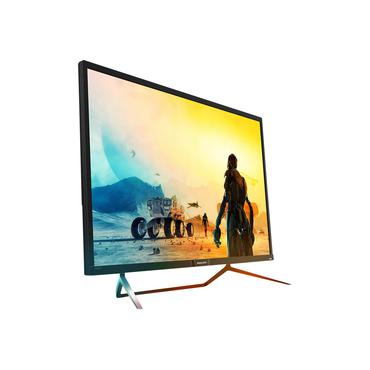
A TV-monitor is what the Philips Momentum 436M6VBPAB is! It’s a hybrid between both, combining the massive screen and TV-like stand, yet without the connectors that come in TVs, which make it a monitor.
If you think a 32-inch screen is massive, take this one. This monitor is a 43-inch 4K monitor, featuring a VA panel. In addition, it supports HDR 1000 completely!
With its bright display of 1000 units, contrast, and satisfactory response rate, the Philips Momentum 436M6VBPAB is totally equipped for the gaming experience, while also being equipped with the Quantum Dot Technology for color accuracy.
Going a little further with the ports, this monitor has two HDMI 2.0 ports, one DisplayPort 1.4 input, a Mini DisplayPort 1.4, two USB ports (3.0), a USB-C port, and two 3.5mm analog jacks.
AMD FreeSync technology is also present on this monitor in the 48-60 Hz range, again useful for usage with PC or Xbox, but not really the best PS4 Pro option, since the monitor’s refresh rate is 60 Hz, with a response rate of 4ms.
Given its size, this Philips Momentum model’s VESA supports uses a 200×200 instead of the usual 100×100 VESA pattern, to be able to handle the size. In addition, going back to the “TV-like aspects,” the monitor has dual 7-watt speakers, which is far more than what’s found in traditional monitors.
Pros:
- Massive 43-inch 4k display
- HDR 1000 support
- VA Panel Display Technology
- 200×200 VESA support
- Integrated speakers
- Could be used as a TV too
- Low motion blur and input lag
Cons:
- AMD FreeSync only for Xbox monitor
- Expensive
Bottom Line
If you’re a gamer yet you don’t enjoy having too many monitors at home, you’ll find the Philips Momentum 436M6VBPAB convenient due to its ability to serve both purposes. It looks good enough to work as a TV and works responsively enough to work as a monitor for those gamers who love big screens.
5. LG 27UL650-W – 4K HDR Gaming Monitor With FreeSync
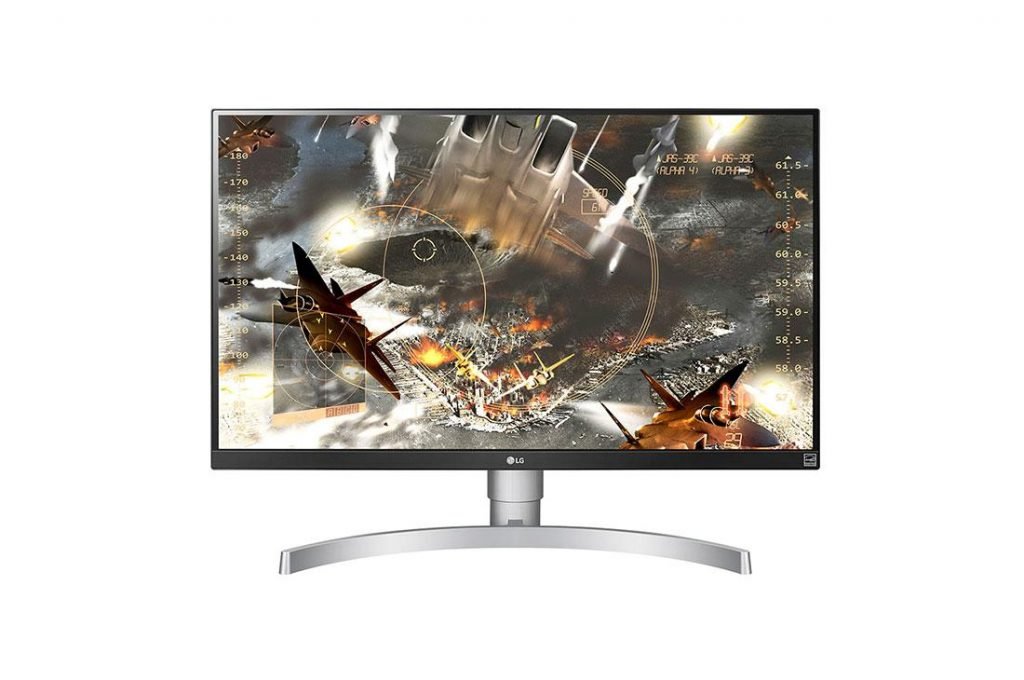
The LG 27UL650-W is an upgrade over the LG 27UL500, now capable of providing outstanding color vividness with HDR support features, smoothly moving it to one of the ideal choices for HDR monitors and console gaming.
It’s a 27-inch monitor with a contrast ratio of 1000:1, a response rate of 5ms, a refresh rate of 60 Hz, and it has the capability of supporting more than 1.07 billion colors. To add, it’s compatible with HDR10 through the IPS panel, which supports peak brightness ranges of 400 nits and colors exceeding those of similar monitors.
The monitor provides limitless gaming features to enhance gamers’ experience, including AMD FreeSync technology for a gaming experience without stuttering and tearing, Dynamic Action Sync for seamless movement, and high resolution, Black Stabilizer to reveal minute details specifically in dark scenes, and gaming profiles.
Concerning ports, the LG 27UL650-W has a display port 1.4, two HDMI ports (2.0), and audio jack. It also includes built-in speakers and is compatible with VESA, although the monitor is highly adjustable itself.
Pros:
- Sleek design
- HDR10 compatibility
- 400 nits peak brightness
- Multiple viewing angles
- 5ms response rate
- Diverse gaming features
- Highly adjustable
Cons:
- Low contrast ratio for HDR
- Stand lacks swivel option
Bottom Line
The LG 27UL650-W offers superb gaming display for gaming, especially. Being HDR-enabled undoubtedly makes a difference in the ways games look, which makes it well worth the more expensive price point than its predecessor, the LG 27UL500. Value for money, indeed!
6. BenQ EX2780Q – Optimal All-Rounded Gaming Experience
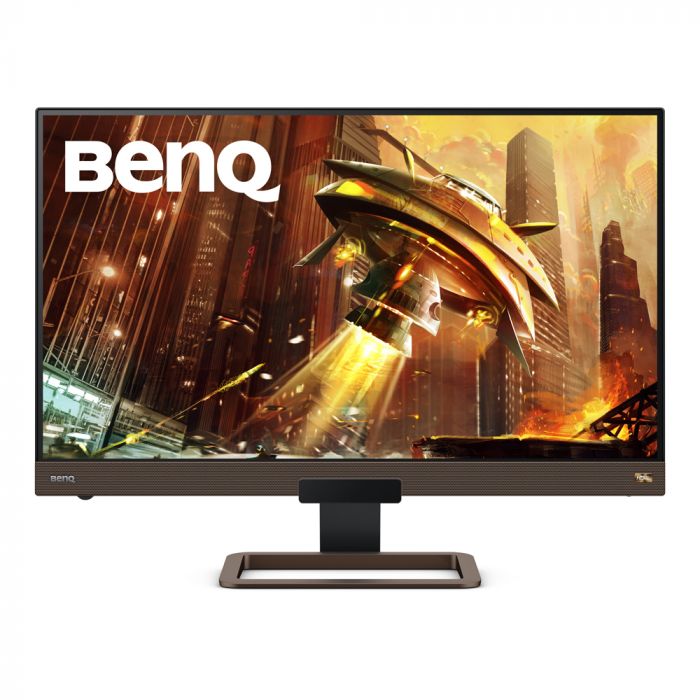
The BENQ EX2780Q is a monitor that gives you exactly what you pay for. In other words, it’s a bang for your buck that is undoubtedly one of the best 27-inch 1440p gaming monitors you’ll come across.
In terms of visuals, the QHD picture is outstanding with vibrant colors, and the contrast is just right. Also, the monitor features HDRi, which adapts HDR to fit the surrounding light, making your visuals as good as 3D. To complete the package, it has an integrated 2.1 audio system, delivering the perfect audio to go with your visuals.
Moreover, the monitor utilizes a 10-bit panel, which enables it to show above one billion colors across 95% of the DCI-P3 color gamut, which is super impressive!
As for the gaming operations, the BENQ EX2780Q has a 144 Hz refresh rate, enabling very smooth and effortless movements, along with a 5ms response rate.
Port-wise, the BENQ EX2780Q has two HDMI ports, one DisplayPort, and one USB-C port. The monitor comes with an only adjustable stand, but that seems to be shared among monitors since they allow for VESA mounting as an alternative.
Pros:
- Solid, appealing design
- Well-Rounded audio and visual experience
- Ideal refresh and response rates
- Vivid color views
Cons:
- Relatively expensive
- Lacks 4K
- Stand only tilt-adjustable
Bottom Line
You get what you pay for should be the slogan of the BENQ EX2780Q, a monitor that suits gamers and competitive gamers alike. Equipped with features that enable gamers to live an experience that’s nearly tangible through its strong visual and audio capacities, along with features specific to gamers.
7. Samsung U32J590 – Affordable 32″ Gaming Monitor

The Samsung U32J590 is yet again another budget 4K monitor, but with a unique selling proposition, being its size. It’s one of the largest, with a diagonal of 32 inches, wrapped in a neat design.
Along with its very convenient size, the Samsung U32J590 monitor adopts the VA panel display technology, the best contrast (3000:1), and image depth, among other types of display panels. In addition, it’s equipped with Samsung’s Quantum Dot technology, which allows it to offer true to life color reproduction.
As for ports, the monitor comes with three ports: two HDMI ports (an HDMI 2.0 and an HDMI 1.4), and a single DisplayPort 1.2 input. This is in addition to a headphone jack.
On the downside, many gamers don’t prefer monitors of this size, and this is where they are correct: the performance. The Samsung U32J590 isn’t ideal when it comes to performance, having the basic 60 Hz refresh rate and 4ms response time, which is not satisfactory for competitive gamers. In addition, the monitor doesn’t support HDR.
In an attempt to compensate for that, the monitor is AMD FreeSync enabled in the 40-60 Hz range, so if you pair it with a GPU that would grapple with maintaining a stable 4K frame. Do note, however, that this applies to the Xbox monitor only and not the Playstation 4 one.
For adjustability purposes, the monitor comes with a basic adjustable stand for tilting. Yet again, like the LG27UL500, it has VESA support compatible with any 100×100 VESA stand or wall mount for more flexible options.
Pros:
- Budget-friendly
- Large screen
- VA Panel Display Technology
- Game Mode for better visibility in dark scenes
Cons:
- Doesn’t support HDR
- Basic functioning adjustable stand
- AMD FreeSync support only for Xbox monitor
- Average performance
Bottom Line
A 32-inch 4k gaming monitor at an approachable price-point seems like mission impossible. The Samsung U32J590 proves otherwise, though, making it an attractive buy for console gaming, which gamers will fall in love with mainly because of the VA display.
8. Samsung C27HG70 – Top Curved Gaming Monitor

The Samsung C27HG70 is a mid-range option that offers the best of both worlds in terms of features and display, which is why this HDR monitor made it to this list, especially that HDR makes games appear much closer to real-life from how rich and crystal clear they are.
It’s a curved 27-inch 1440p monitor that uses a VA panel, so contrast and image depth are in your pocket. On top of that, it supports refresh rates of up to 144 Hz and 1ms response rate, which is beyond perfect for gaming.
On the port’s front, the Samsung C27HG70 has two HDMI ports (2.0), one DisplayPort 1.4, two USB ports (3.0), a 3.5mm audio output jack, and a microphone jack as well.
Being a 144 Hz HDR monitor, the monitor includes AMD FreeSync 2 in the 48-144 Hz range via DP and in the 48-100 Hz range via HDMI.
This might take you by this surprise, but this monitor comes with a very flexible and adjustable dual-hinge stand that not only tilts but also supports pivot and swivel adjustment. It tends to occupy some space, but you won’t want to let go of it. The monitor is also compatible with 100×100 VESA mounts.
Pros:
- Curved VA display
- 144 Hz refresh rate
- Very flexible adjustable stand
- AMD FreeSync 2 support
Cons:
- Limited viewing angles
- The stand can occupy significant space
- Setting up is tedious
- Prominent clouding in dimly lit areas
Bottom Line
Exceedingly higher refresh rates than the usual, no motion blur, responsiveness, and top-notch display are the distinguishing features of the Samsung C27HG70 HDR monitor, making it a well-rounded one for the best PS4 Pro gaming experience, but not for co-op gaming.
What To Look For When Buying a Monitor for PS4 Pro
1. Panel Type
There are three main panel types for gaming monitors: twisted nematic (TN monitor) panels, vertical alignment (VA monitor) panels, and in-plane switching (IPS monitor) panels.
TN panel type monitors are commonly used by competitive gamers, principally because they have the fastest response times and are the only type of panel able to achieve a 240 Hz refresh rate. These are mainly their edges, yet they’re not as competitive when it comes to image quality and viewing angles.
VA panel type monitors top TN panel type ones in that regard, offering the best contrast ratio and providing colors true to reality, and also offering wider viewing angles (178-degree). Yet, since nothing is perfect, VA panel types have relatively slow response times, causing ghosting and motion blur when fast movements are involved in the game. However, their refresh rates can reach 144 Hz.
Offering the best of both worlds, IPS monitor type panels have the most accurate and vivid colors, although not with high contrast as VA panel types, and they have the widest viewing angles as well. While they don’t compete with the response time of TN type panels, they’re much more responsive than the VA panel type, can reach 144 Hz refresh rates, and won’t cause ghosting. Their downside? They’re expensive.
2. Resolution
Resolution is an undeniably important aspect of a gaming monitor. These are the standard resolutions you will come across: HD Ready (720p), Full HD (1080p), Quad HD (1440P), and Ultra HD (2160p).
HD Ready resolution is the least common in today’s advancing technological era, but that doesn’t mean it’s non-existent. It’s still the resolution of low-end office monitors, TVs on the cheap end of the spectrum, and laptop screens. Genuine gaming monitors are unlikely to adopt this resolution, so if you come across one, beware.
Full HD resolution is the most dominant today since it’s an enabler for good game performance. It may not be the top-best, but it’s good enough and within reach of most gamers! It would work best with mid-range GPUs to not lower the graphic settings in the extreme games, but low-end ones are also able to support it. It’s perfect for competitive gamers who can obtain triple-digit frame rates with triple-digit refresh rates.
As for Quad HD, it’s expected to replace the Full HD resolution quite soon, and it’s found mostly in mid-range to high-end gaming monitors, pushing beyond 60 FPS. It strikes a balance between quality and performance, and most high-end graphics cards can easily launch games in QHD at an ideal 60 frame rates per second.
Ultra HD (UHD/4K) is the king. It’s considered the future of gaming monitors, but currently, it’s only found on high-end monitors. This high resolution offers visuals that are incomparable to other types, so real that it almost brings the game to life.
3. Screen Size
Bigger is not always better, especially for gamers! In fact, many monitors are larger than their resolution can handle, which accordingly leads to lower pixel density. In other words, the visuals end up being much less sharp and crisp than they should be.
In general, a 24-inch gaming monitor is ideal for a resolution of 1080p, while a 27-inch monitor is fit for 1440p and 2160p.
Gaming monitors above 27-inches are likely to suffer lower pixel densities, especially for 16:9 displays.
4. Aspect Ratio
Another element related to screens of gaming monitors is the aspect ratio. There are two dominant aspect ratios: 16:9 (known as widescreen), and 21:9 (known as ultrawide).
By definition, “wide” in this context refers to larger screens. Ultrawide monitors have wider fields of view in games, and they work for different purposes other than gaming. You can use them for work, web browsing, watching videos, and more.
Moreover, curved ultrawide monitors make you delve deep into the gaming world, so that’s a plus!
On the other hand, because some gamers try to outsmart other gamers during competitive games and tournaments, many developers have started disabling fields of view adjustment in competitive games to prevent unfair advantages for the gamers with larger monitors.
Furthermore, as previously discussed, larger screens require higher resolution to avoid the common issue of low pixel density. So again, before opting for ultrawide monitors, be sure that your GPU can handle it.
5. Response Time
The response time of a gaming monitor, measured in milliseconds (ms), indicates the speed by which a pixel can turn from a color to another, from black to white, or from a shade of grey to a different one.
It further indicates how fast-moving visuals will appear, to what extent they will be blurry, and whether ghosting will be a concern.
On average, response times range from 1ms-4ms, depending on the type of the monitor panel, with TN panels being the fastest, as mentioned, being the only ones to reach 1ms. As for IPS and VA panels, they don’t go less than 4ms, except with the use of panel technologies.
While the gap between response times doesn’t seem like a wide one, the difference between a 1ms response time and a 4ms response time is noticeable, particularly in games with a fast-pace. If you’re not involved in games with such pace, then IPS and VA response times will serve you fine.
6. Refresh Rate
The refresh rate of a gaming monitor, measured in Hertz (Hz), indicates how many times the monitor can refresh the display per second. The higher the rate, the better, because it corresponds to the maximum number of frames that your monitor can display per second.
For a higher FPS, which brings with it smoother movements, enhanced responsiveness, and less motion blur, you should keep your eye out for a high refresh rate.
The majority of monitors have a refresh rate of 60 Hz, but a few others have a refresh rate as high as 144 Hz or 240 Hz. It’s worth noting that after a certain FPS, the difference becomes less noticeable. The difference between 30 and 60 FPS, for instance, is highly visible, but the difference between 60 and 144 FPS, not so much.
Tip: Upon deciding on your desired refresh rate, factor in the capabilities of your GPU and the type of games you play. If your GPU can support playing games at frame rates exceeding 60, then you could use a higher refresh rate, and vice versa.
Frequently Asked Questions:
Is It Worth Getting a 144 Hz Monitor for PS4 Pro?
No, PS4 Pro is limited to 60 Hz. If you do run it at 144 Hz, the quality of the graphics will suffer significantly since such a monitor is not compatible with PS4 Pro. It’s not beneficial for you to buy it for that purpose; your money will go to waste.
Is It Worth Getting a 4K Monitor for PS4 Pro?
If you want a truly enjoyable gaming experience, then yes! 4K monitors have significant competitive advantages over regular TVs, response time, and less lag, to name a couple. It’s well worth the money, especially if your games are 4K compatible.
What Is the Best 4K Monitor for PS4 Pro?
While there are many decent 4K monitors, a few stand out. The best 4K monitor for PS4 Pro that is also on the affordable side of the spectrum is the Asus VP28UQG, with a TN panel offering a response rate of 1ms and a refresh rate of 60 Hz. This is in addition to its eye protection technology and wide viewing angles, making it perfect for competitive gamers.
If you’re after the best budget 4K monitor, then the LG 27UL500 would be your safest bet with its HDR-compatible IPS panel, which creates a lively gaming experience with extra vivid graphics, along with game setting features for different game modes. Its refresh rate is 60 Hz, and the response rate is 5ms.
Is It Better to Play PS4 Pro on Monitor or TV?
Monitors are best for playing games and are the best PS4 Pro convenient. TVs generally have high input lags (the time a monitor or TV takes to react and display your commands), low refresh rates, and low response times. On the other hand, monitors have lower input lags, higher refresh rates, and faster response times.
Monitors are explicitly optimized for playing games, while TVs generally multitask.
Final Thoughts
Out of all monitors mentioned on this list, the best gaming monitor for PS4 Pro would undoubtedly be the ASUS VP28UQG, with its edge being the TN panel offering a response rate of 1ms and a refresh rate of 60 Hz for competitive gamers at a decent price.
If you’re a gamer whose more interested in the experience itself, then your choice should be the ASUS VG289Q, which will level up your gaming experience to unbelievable heights due to its exclusive gamer features along with the superb display.
Lastly, for a budget alternative, the LG 27UL500 is a go-to with a unique selling point of an HDR-compatible IPS panel which creates a lively gaming experience with extra vivid graphics for those who care about visuals more than gaming performance.
- Check out our guide to the best monitors for Xbox One X
